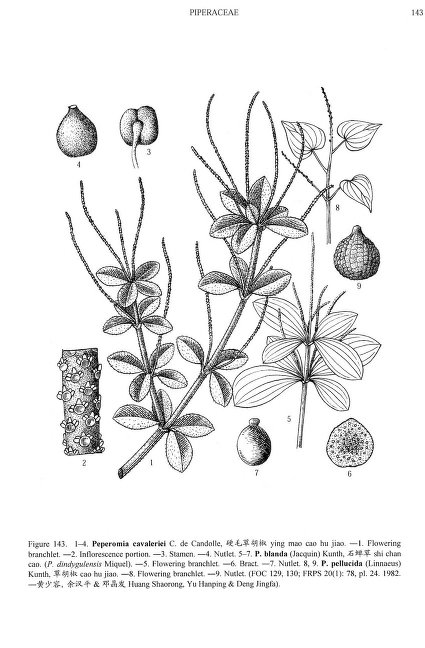Scientific Name
Peperomia pellucida (L.) Kunth
Synonyms
Piper pellucidum L, Peperomia exigua Miq, Piper concinnum Haw. [1]
Vernacular Name
| Malaysia | Ketumpangan air [2] |
| English | Common pellucida, shiny bush [2] |
| Indonesia | Rangu-rangu, sladanan, suruhan (Java); sasaladaan (Sundanesse) [2] |
| Thailand | Kasang pak [2] |
| Philippines | Pansit-pansitan [2] |
Geographical Distributions
Peperomia pellucida is tropical and occurs everywhere particularly as a weed in garden pots and grassy areas. [2]
Botanical Description
P. pellucida is a dwarfy, green herb with fleshy and translucent stems grows to a height of 20 cm. [3]
Cultivation
No documentation
Chemical Constituent
The main components of the essential oil of P. pellucida are dillapiol (39.7%) and trans-caryophyllene (10%). [4]
Pellucidin A and dillapiol have been isolated from the aerial parts of P. pellucida. The previous chemical investigations have reported the occurrence of apiol, 2,4,5-trimethoxystyrene, flavones, flavonols and phytosterols. [5]
The phytochemical screening of the plant gave positive tests for anthraquinones, cardiac glycosides and tannins. [6] In addition, the methanolic extract indicated the presence of alkaloids, flavonoids, saponins, sterols, tannins and triterpenoids. [7]
The bioassay-guided fractionation of ethanolic extract of aerial parts of P. pellucida gave linoleic acid and α-linolenic acid. The water fraction obtained after elution of a Celite column with hexane, ethylacetate, ethanol and water yielded Na, K, Ca and Mg cations which represented about 25% of the water fraction. [8]
Other chemical constituents include: essential oil and flavonoids [7], peperomins A-E, acacetin, apigenin,isovitexin,pellucidatin,7,8-trans-8,8’-trans-7’8’-cis-7,7’-bis(5-methoxy-3,4-methylenedioxyphenyl)-8-acetoxymethyl-8’-hydroxymethyltetrahydrofuran, 7,8-trans-8,8’-trans-7’,8’-cis-7-(5-methoxy-3,4-methylenedioxyphenyl)-7’-(4-hydroxy-3,5dimethoxyphenyl)-8,8’-diacetoxymethyltetrahydrofuran, sesamin, isoswertisin, campesterol and sigmasterol. [9][10]
Plant Part Used
Entire plant, leaf [3]
Traditional Use
Malays are believed to have used this plant as a treatment for rheumatism and fatigue. In the Philippine Islands, the plant is applied as a poultice to heal abscesses and boils. It is reputed to be a remedy for asthma. An infusion of the plant is claimed to have been used to treat convulsions. [3]
In Java, the crushed leaves are used medicinally as an application to treat fever and headache while the extract is used to relieve abdominal pain and colic. [3]
Preclinical Data
Pharmacology
Analgesic activity
The methanol extract of P. pellucida aerial parts, given orally to Swiss mice at doses ranging from 70 to 210 mg/kg, showed a significant and dose-dependent analgesic effect on acetic acid-induced writhing over a period of 20 min. [6]
An aqueous extract of the aerial part of P. pellucida was tested for analgesic activity (abdominal writhes and hot plate) in rats and mice. In the acetic acid-induced writhing test, the plant extract demonstrated a significant analgesic effect at 400 mg/kg dose. In the hot-plate test, an analgesic effect was observed at concentartions of 100 and 200 mg/kg. [11]
Antibacterial activity
The methanolic extracts of Hygrophila stricta and P. pellucida were fractionated into petrol, dichloromethane, ethyl acetate and butanol. The fractions exhibited a higher antibacterial activity than the crude extracts. The petrol fraction of H. stricta and the butanol fraction of P. pellucida were particularly good with values of inhibition zones of 18-20 mm. [7]
Anticancer activity
The peperomins have cytotoxic or anticancer activity in vitro on three cancer cell lines. [10]
Anti-inflammatory activity
No previous literature data have confirmed the anti-inflammatory properties of P. pellucida herb. So on this basis, an investigation to this effect was carried out on an aqueous extract of this plant. The oral administration of 200 and 400 mg/kg of crude aqueous extracts in rats and mice, exhibited an anti-inflammatory activity in both the carrageenin test and the arachidonic acid test. The results showed that the aqueous extract presented a dose-dependent anti-inflammatory activity at all concentrations tested. [11]
Toxicity
No documentation
Clinical Data
Clinical findings
No documentation
Precautions
No documentation
Side effects
No documentation
Pregnancy/Breast Feeding
The plant interferes with prostaglandin synthesis. Avoid use because of lack of information regarding pregnancy and lactation. [8]
Age limitation
No documentation
Adverse reaction
The plant has a strong mustard-like odour and may cause asthma-like systems in patients with known hypersensitivity reactions to the herb. [8]
Interaction & Depletion
No documentation
Contraindications
The patients with known hypersensitivity reactions to any of the components of the herb should avoid using. [8]
Case Report
No documentation
Poisonous Management
No documentation
Line Drawing

References
- The Plant List. Ver1.1. Peperomia pellucida (L.) Kunth [homepage on the Internet]. c2013 [updated 2012 Apr 18; cited 2017 June 14]. Available from: http://www.theplantlist.org/tpl1.1/record/kew-2556385
- Wiart C. Medicinal plants of The Asia-Pacific: Drugs for the future?. Singapore: World Scientific Publishing, 2006; p. 43.
- Herbal Medicine Research Centre, Institute for Medical Research. Compendium of medicinal plants used in Malaysia. Volume 2. Kuala Lumpur: HMRC IMR, 2002; p. 207.
- Da Silva MHL, Zoghbi MGB, Andrade EHA, Maia JGS. The essential oils of Peperomia pellucida Kunth and P. circinnata Link var. circinnata. Flavour Frag J. 1999;14:312-314.
- Bayma JD1, Arruda MS, Müller AH, Arruda AC, Canto WC. A dimeric ArC2 compound from Peperomia pellucida. Phytochemistry. 2000;55:779-782.
- Aziba PI, Adedeji A, Ekor M, Adeyemi O. Analgesic activity of Peperomia pellucida aerial parts in mice. Fitoterapia. 2001;72:57-58.
- Khan MR, Omoloso AD. Antibacterial activity of Hygrophila stricta and Peperomia pellucida. Fitoterapia. 2002;73:251-254.
- Bauer R, Michael H, Koehler I, Rimpler H. Bioactive compounds from the mixe Indian medicinal plant Peperomia pellucida. J Mex Chem Soc. 1998;42:245-248.
- Drugs.com. Peperomia pellucida [homepage on the Internet]. c2000-2014 [cited 2007 Dec 29]. Available from: http://www.drugs.com/npp/peperomia-pellucida.html
- Xu S, Li N, Ning MM, Zhou CH, Yang QR, Wang MW. Bioactive compounds from Peperomia pellucida. J Nat Prod. 2006;69:247-250.
- Arrigoni-Blank MDF, Dmitrieva EG, Franzotti EM, Antoniolli AR. Anti-inflammatory and analgesic activity of Peperomia pellucida (L.) HBK (Piperaceae). J Ethnopharmacol. 2004;91:215-218


